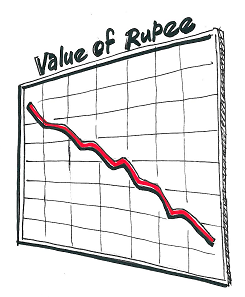Dec 28, 2025
Dec 28, 2025
 The study has revealed that in 2010-11 the share of Rs. 500 denomination bank notes “has gained significance and accounted for 47 per cent of the total currency in circulation”. These quickly emerged as the second most important denomination since 1998-99 and soon became most important denomination in 2003-04 replacing Rs 100 denomination. The report further indicated that the Rs. 100 bank notes which had a significant presence in circulation even after introduction of the Rs. 500 note lost their second position after introduction of the Rs.1000 bank notes in 2007-08 that came to account for 27 per cent of the total currency in circulation. Accounting for close to 50 per cent of the value of the total currency in circulation from 1970s to 1990s, the share of Rs 100 steeply declined to 14.8 per cent in 2010-11.
The study has revealed that in 2010-11 the share of Rs. 500 denomination bank notes “has gained significance and accounted for 47 per cent of the total currency in circulation”. These quickly emerged as the second most important denomination since 1998-99 and soon became most important denomination in 2003-04 replacing Rs 100 denomination. The report further indicated that the Rs. 100 bank notes which had a significant presence in circulation even after introduction of the Rs. 500 note lost their second position after introduction of the Rs.1000 bank notes in 2007-08 that came to account for 27 per cent of the total currency in circulation. Accounting for close to 50 per cent of the value of the total currency in circulation from 1970s to 1990s, the share of Rs 100 steeply declined to 14.8 per cent in 2010-11.
16-Jun-2013
More by : Proloy Bagchi

|
Thanks for the comments. As for rdashby's comment one has to concede that over the years social sector reforms have made a dent and lately the money poured into the sector has certainly lifted up the masses who were earlier languishing in abject poverty. FMCGs are being lapped up in once poverty-stricken areas and the Indianised MNCs have developed strategies to feed the the growing rural market. Denims and fancy T shirts are common in the shanties where one would find motor bikes and white goods too. All this has stoked the demands for virtually all essentials and the prices have gone through the roof. Ironically, however, the work culture and ethics in conduct is no longer what they used to be in those gone-by days. That with the losing Rupee is a kind of a double whammy. Even if you pay thorugh your nose you are in all likelihood will be shortchanged. |

|
As a boy in India, I recall the transition from the old money to the new 'decimal' currency. It was in step with global modernization, the identity of the age - the dacron suits, nylon shirts, hi-fi sets, Hollywood movies - though not yet TV. Not merely this, but the poor class that served the urban middle class was as yet untouched by notions of ‘improving’ their lot - bearers, ayahs, bochis and jamadars that derived their glory from their affluent masters, and were 'happy to serve' ( that fated to become scandalous phrase) content with their easily affordable (by their masters) wages (thalab) that were yet adequate for subsistence in the bustees they returned to at the end of the day. The revolution in outlook was shortly to follow, but I had left for the UK. The decline of the purchasing power of the rupee seemed to be in direct proportion to the rise of the servant class in terms of being made aware of their dignity and human rights where once it had never occurred to them: suddenly, I heard reports of UK style labour union attitudes, of servants being redefined as helpers; and a corresponding expectation of higher wages in all service industries. This 'dignity of labour' mind-set was long established in the UK (courtesy of the Trade Union movement) when I disembarked at Tilbury docks in early 1962: here I witnessed porters and bus drivers and street-cleaners with middleclass lifestyles and expectations - domestic servants nowhere to be seen, only their mechanical equivalents in white goods, electric hoovers and affordable cars. The high street shops were accessible to the working class, and geared to supplying their needs; as opposed to even the idea of your bearer, ayah or jamadar entering shops in Calcutta. One with this high living wage expectation of the working class, now come to India, was an economy that adjusted in high prices, particularly in the housing market. It is ironical that the idea of social justice, the equal rights of all citizens to the good life, living on one plane of opportunity, the expectation of a minimum wage to subsist on, appears to be an element in the spiralling costs of living in any modern society, and, as your article observes, in the depreciation of the value of the currency, leaving the poor just as they were before, even with dignity. |

|
Mr. Bagchi I found the article interesting.Yes we too had Masala Dhosa in Ahmedabad at 4 annas with sambhar refill 6 times.It is being predicted that the 70 Rs would make one USD by the end of 2013. |